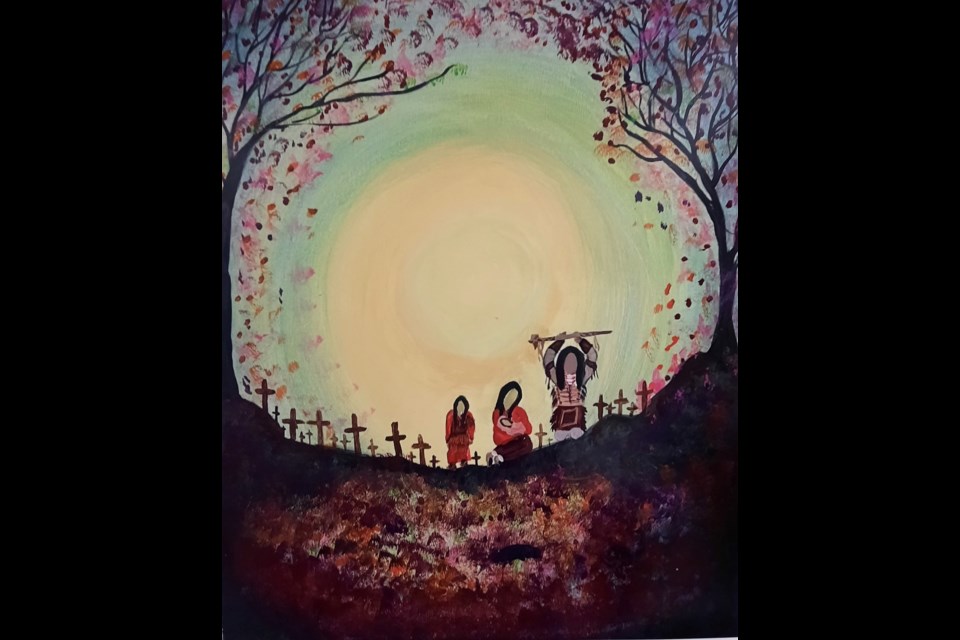ATIKOKAN —Anishnawbe artist Melanie Montour, also known as Lynx, and owner of Native Artisan Designs in Atikokan is presenting her first solo exhibition, Reclaiming My Sovereignty until March 25 at The Pictograph Gallery in the lower level of Voyageur Mall.
Montour was born in Fort Frances in 1969. Montour said that Dad is from Nigigoonsiminikaaning First Nation.
At the age of one, Montour was taken from her family during the Sixties Scoop and relocated to Six Nations Mohawk Reserve outside of Brantford in Southern Ontario where the Montour family adopted her.
In 2020, Melanie moved to Atikokan, where she desired to reclaim her roots in the Seine River traditional territory.
“I did meet them both before they passed. My dad was fluent in English and Ojibway and my mom only spoke Ojibway,” said Montour.
Upon meeting her mother, Montour needed an interpreter because she mainly spoke English and a little bit of Mohawk, Onondaga, and Odawa.
However, since moving back to northwestern Ontario, she has reconnected with family members in Couchiching First Nation, Seine River First Nation and Nigigoonsiminikaaning First Nation.
Montour's adoptive mother was a librarian at the Woodland Indian Cultural Center where she provided resources to her Anishnawbe heritage.
It was through these resources that Montour began to feel passionate about the world of art.
“I was always into art. When I was a little kid. I learned how to do letter work first and I did a lot of artwork when I was in school. I was one of the better artists in my school. I was always painting or picked for projects,” said Montour, “In my 20s, I was learning how to do a lot of beadwork.”
During her 20s, Montour registered for an apprenticeship program for native clothing and craft artisans.
“This is where I learned to do a lot of different techniques throughout North America. It was my own initiative and I wanted to learn as many things as I could learn about different styles of art throughout Turtle Island,” said Montour.
Montour said she wanted to become a professional artist, but unfortunately, she did finish her degree. Although, that didn’t stop her. She began teaching her craft through workshops in the Brantford area.
“I broke things down. I was able to teach people how to do workshops,” Montour said.
In 1996, Melanie moved to Toronto where she worked in administrative jobs and continued learning marketing, wholesale, and retail. While in Toronto, she sold her art as a street artist.
“I would basically make my money to buy more supplies. I would travel around and do shows and exhibits. I would get invited out for different things. I got invited out to the North American Indigenous Games in Toronto and I got invited to the Ontario Summer Games around 2015. I got invited out a lot. I was kind of in the right place at the right time for a lot of the stuff that I was doing,” Montour said.
As she began to become more recognizes in the Toronto area Montour began to use her art as a talking point regarding the injustices experienced by indigenous people and the attempted erasure of Indigenous culture. Seeing her art as part of the story of Indigenous people, her human rights advocacy promoted a path of resistance through art.
“I promoted a lot of Indigenous awareness and I got to meet a lot of youth advocates in the United Nations,” said Montour. “I had about a two-hour conversation with them about something that was kind of pressing.”
Indigenous culture, history and current events reflect a lot of Montour’s work.
Montour said when she starts a new project she doesn’t begin with any clear goals in mind. She let her imagination and life experience guide her.
“Sometimes it comes from a topic of interest like Bring our Children Home and the graves. Stuff I’ve done with the resistance. I’ve done a lot of crazy things as far as that goes,” said Montour. “It never made the news or something that was worth of mainstream media, so I just stick to my art now. Plus, I’m getting older. I’ve been on the front line with the resistance. I’ve got arrested for different things. I’m just trying to bring awareness out again.”
In 2016, Montour began experimenting with acrylic paints. Her painting “Mother Earth is Alive” utilizes hues of bright colour to present the sky, which juxtaposes the darker colours for the trees and soil that frame the grieving family kneeling around the graves.
“It was something that came from deep down,” said Montour. “That’s one thing. To reclaim Indigenous sovereignty is to resist the colonial mindset and the colonial constructs.”
When ask if there were a few pieces that she was most proud of, Montour said “The Alien Invasion,” the “Merman,” and the “Bears on the Land” were her favourite pieces. She points out that these pieces took her a while to finish because of the difficulty of getting the colour right.
“The layer of paint that goes into getting it to the point that you feel like it’s kind of done is probably about 12 hours or more for the brighter ones,” said Montour.
For those people who are finding their passion for art, Montour said expression is the key.
“Don’t be afraid to express yourself. Don’t be afraid of the colours and don’t be afraid to learn,” said Montour.
Montour pieces can be purchased at The Pictograph Gallery on the lower level of Voyageur Mall.



